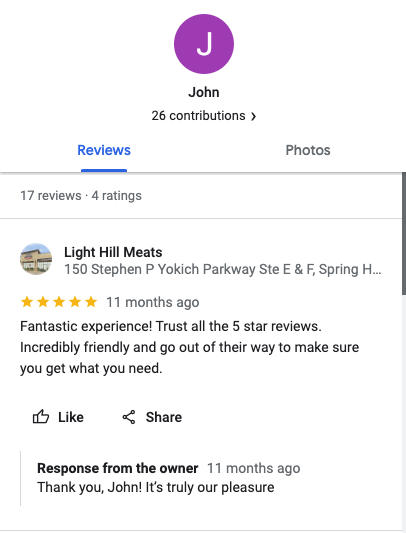In the competitive and ever-evolving home-building industry, trust is not just a currency—it’s the cornerstone of a successful company. 93% of your potential customers read online reviews before buying your product, and 81% check Google Reviews first. How you respond to online reviews is pivotal to turning prospects into leads. But how do you respond?

Dealing With Reviews: The Good
Positive customer feedback is more than just a pat on the back; it is an authentic testament to your commitment to excellence. Plus, it helps your local SEO too. Once you receive a positive review, take these steps to magnify it:
Give It a Personal Touch: Nothing beats a personal touch. Include the person’s name (if you know it) in your response. Also, reference any personal interaction a salesperson, designer, etc., may have had with the reviewer. Make them feel like they’re getting a high-five from a friend. Of course, being this specific may be more difficult if you are a larger homebuilder. But at least aim to get away from templated or one-sentence responses.
Keep It Professional, Keep It Fun: It’s all about blending that professional tone with a bit of sparkle. The customer must see you’re serious about the feedback but also that you’re excited about their positive input. Also, give that reply a quick once-over for any mistakes. A neat, error-free message adds to your shine. Keep the response professional, but have fun with it!
Address Any Concerns: Positive reviews may include minor concerns or suggestions. Take this chance to address it and assure the customer that their feedback is valued and will be considered. This interaction can turn a potentially negative issue into a positive one. You are showing your commitment to constantly improving for your customers. When you respond, you also address potential customers who might read it later.
Share the Love: If you receive positive reviews on any of your platforms, amplify them through other channels. If you see a positive review on your Google My Business profile, share it on Twitter and Facebook. If someone leaves glowing glowing praise on LinkedIn, add it to your Google My Business feed. This sharing will increase potential customers’ opportunities to check out your work.
![]()
Dealing With Reviews: The Bad
We all receive negative reviews. It happens. Negative reviews can damage your reputation and spread faster than positive reviews; according to Hubspot, a person with a negative experience with your brand or service will tell twice as many people about their bad experience as someone with a positive experience. Even more troubling, customers with a negative experience are 26 times more likely to leave an unsolicited review. So, complainers love to complain. But, sometimes, those complaints are legitimate. So take these steps:
- Respond Promptly: When a negative review pops up, it’s usually right after the issue occurs. Responding quickly not only shows you care but also helps mitigate any fallout.
- Respond with Care: Besides speed, it’s crucial to value every piece of feedback, particularly the negative ones. Such insights can pinpoint where your service might be lacking and offer a chance to improve.
- Be Honest in Your Reply: Nobody’s perfect, including businesses. Admitting mistakes can turn a negative experience into a positive one, building trust and loyalty.
- Maintain Professionalism: No matter how harsh a review may be, always respond with kindness and professionalism. An apology can go a long way in maintaining your brand’s integrity.
- Personalize Your Responses: Show customers they’ve been heard by crafting personalized responses. It demonstrates empathy and genuine care for their experience.
- Avoid Personal Attacks: Keep responses professional and focused on the issue, not the individual. Personal attacks can only harm your business’s reputation.
- Move the Discussion Offline: Try to continue the conversation privately. This approach can help resolve issues more effectively without escalating publicly.
- Express Gratitude: Appreciate all feedback, even the negative. It provides an opportunity to address issues and improve your service.
- Follow-up: If you’ve addressed their concerns, see if they agree with the response. Happy customers might even remove their negative reviews.
- Offer Compensation When Needed: In cases of significant inconvenience or loss, offering compensation can help soothe frustrated customers. Make the deal privately; otherwise, you risk former customers asking for similar deals even if it’s not warranted.
Dealing the Reviews: The Ugly
Not all reviews are legitimate. Some fake reviews can be from Bots, random people causing problems, or competitors spamming your reviews. Unfortunately, review platforms have different rules for removing fake reviews. So, even if they are fake, most platforms don’t allow you to delete them.
Identify the Fake Review: Reviews will have a person’s profile associated with them. Check out the profile and review the activity. If there is no activity, someone likely created the profile to leave a negative review. Below is an example of a legitimate Google My Business profile that left a Power Marketing review. You can see other reviews they’ve made for other local businesses.

You can also cross-reference reviews with your customer database. Compare the reviewer’s name and details with your customer records.
Look for patterns with the posting of the review. Are the reviews at the same time each day? Do they use the same language in each review? These patterns can indicate a bot is creating the reviews.
Respond to the Review Quickly: Publicly respond to the review on Google and call it out as fraudulent. This shows other customers that you take feedback seriously and the review doesn’t represent your business.
Flag the Review as Inappropriate: Websites with reviews will give you a section to report fake reviews. In Google My Business, go to your Google My Business listing, find the review, and click the option to report or flag it as inappropriate. Google will then review the report to determine if the review violates its policies. On Facebook, go to the three dots in the right corner of the selected review and click Report Post.
Document Everything: Keep records of your interactions and reports with Google, as well as any evidence that supports your claim that the reviews are fraudulent.
Consider Legal Action: If the fake reviews are damaging and persistent, consult a legal professional to discuss your options.
BONUS: Companies that Claim They Can Remove Bad Reviews
In the 10+ years I’ve been in digital marketing, I am still looking for a company that can remove a bad review. The bottom line is unless the comment violates the platform’s rules, the comment will not be removed. If there is a company that can provide this, I have yet to find it.
